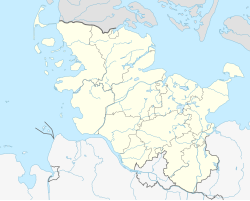Harhoog
In the following article we will explore in depth the fascinating world of Harhoog. From its origins to its impact today, we will delve into the multiple aspects that make Harhoog a topic of interest for people of all ages and professions. Throughout these pages, we will discover the importance of Harhoog in modern society and the relevance it has in various areas. Whether you are an expert in the field or are discovering Harhoog for the first time, this article will provide you with a complete and up-to-date overview of this exciting topic.
 The dolmen in 2012 | |
| Location | Sylt, Schleswig-Holstein, Germany |
|---|---|
| Coordinates | 54°53′27″N 8°22′57″E / 54.8907°N 8.3826°E |
| Type | Dolmen |
| History | |
| Material | Stone |
| Founded | c. 3000 BC |
| Periods | Neolithic |
| Site notes | |
| Discovered | 1925 |
| Public access | Yes |
The Harhoog is a dolmen, a rectangular megalithic tomb from the Funnelbeaker culture, located near Keitum on the island of Sylt in Schleswig-Holstein, Germany.[1] Discovered in 1925, it was moved to the present site in 1954 when a new airport was developed.
Geography

The megalithic Harhoog burial chambers were originally located near the mud-flats between Keitum and Tinnum. The stones were moved to the area near the Tipkenhoog on the coast near Keitum in 1954,[2] when Sylt Airport was under development.[3]: 147
The chambers contain parallel and transverse sections.
History

The graves at Harhoog are dated to the Neolithic and belonged to ancient settlements of the island's Funnelbeaker culture, probably around 3000 BC. There were once around 600 of them but today only about half of them still exist.[4]
The megalithic tombs are built with large, rough stone slabs (one or more) which are arranged in different patterns. Harhoog dolmen is an extended dolmen, under Ernst Sprockhoff's six-category classification; the other five types are simple dolmen, great dolmen, passage grave, long barrows (without a burial chamber) and cist.
Harhhog was discovered in 1925 during excavations of earth for the construction of the Hindenburgdamm, but was only inspected archaeologically in 1936.[3]: 148
References
- ^ Ernst Sprockhoff. Atlas der Megalithgräber Deutschlands - Schleswig-Holstein. Rudolf Habelt Verlag, Bonn, 1966.
- ^ Bierl, Hermann (2006). Archäologie Führer Deutschland: Bodendenkmäler und Museen. Wek-Verlag. ISBN 978-3-934145-39-9. Retrieved 7 February 2013.
- ^ a b Kunz, Harry; Steensen, Thomas (2014). Taschenlexikon Sylt (German). Wachholtz. ISBN 978-3-529-05525-6.
- ^ Jessel, Hans (1999). Schleswig-Holstein. Ellert & Richter. ISBN 978-3-89234-291-5. Retrieved 7 February 2013.
